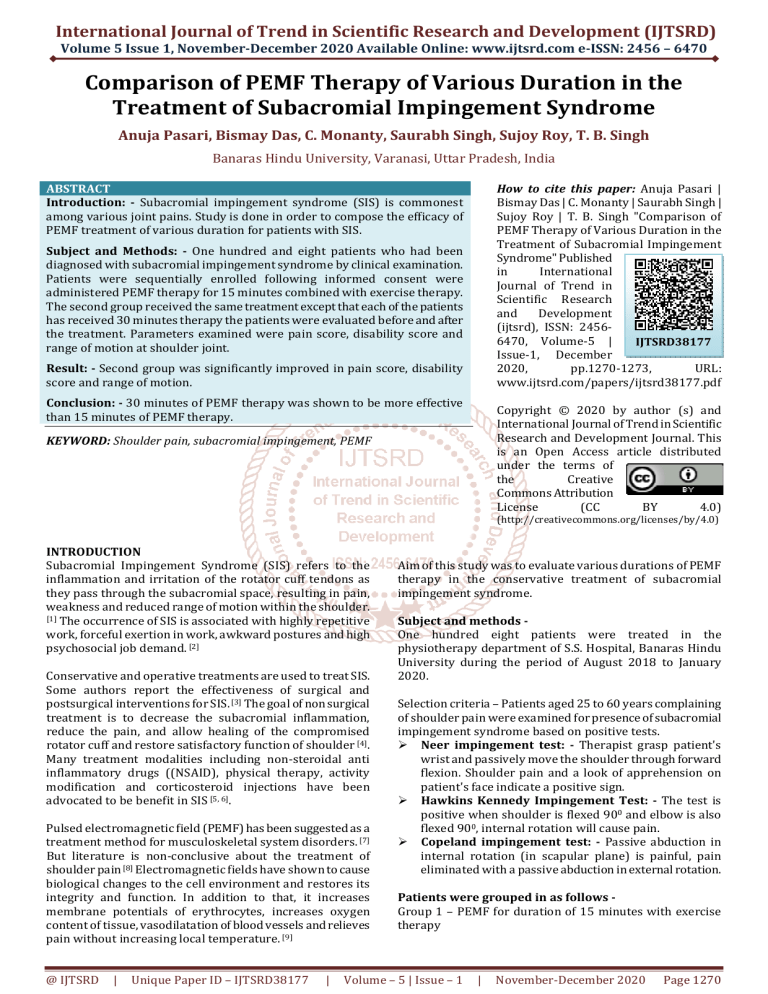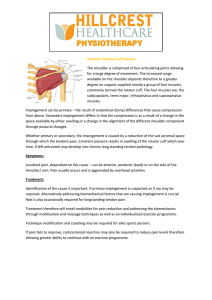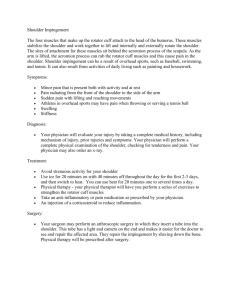
International Journal of Trend in Scientific Research and Development (IJTSRD)
Volume 5 Issue 1, November-December 2020 Available Online: www.ijtsrd.com e-ISSN: 2456 – 6470
Comparison of PEMF Therapy of Various Duration in the
Treatment of Subacromial Impingement Syndrome
Anuja Pasari, Bismay Das, C. Monanty, Saurabh Singh, Sujoy Roy, T. B. Singh
Banaras Hindu University, Varanasi, Uttar Pradesh, India
ABSTRACT
Introduction: - Subacromial impingement syndrome (SIS) is commonest
among various joint pains. Study is done in order to compose the efficacy of
PEMF treatment of various duration for patients with SIS.
How to cite this paper: Anuja Pasari |
Bismay Das | C. Monanty | Saurabh Singh |
Sujoy Roy | T. B. Singh "Comparison of
PEMF Therapy of Various Duration in the
Treatment of Subacromial Impingement
Syndrome" Published
in
International
Journal of Trend in
Scientific Research
and
Development
(ijtsrd), ISSN: 24566470, Volume-5 |
IJTSRD38177
Issue-1, December
2020,
pp.1270-1273,
URL:
www.ijtsrd.com/papers/ijtsrd38177.pdf
Subject and Methods: - One hundred and eight patients who had been
diagnosed with subacromial impingement syndrome by clinical examination.
Patients were sequentially enrolled following informed consent were
administered PEMF therapy for 15 minutes combined with exercise therapy.
The second group received the same treatment except that each of the patients
has received 30 minutes therapy the patients were evaluated before and after
the treatment. Parameters examined were pain score, disability score and
range of motion at shoulder joint.
Result: - Second group was significantly improved in pain score, disability
score and range of motion.
Conclusion: - 30 minutes of PEMF therapy was shown to be more effective
than 15 minutes of PEMF therapy.
Copyright © 2020 by author (s) and
International Journal of Trend in Scientific
Research and Development Journal. This
is an Open Access article distributed
under the terms of
the
Creative
Commons Attribution
License
(CC
BY
4.0)
KEYWORD: Shoulder pain, subacromial impingement, PEMF
(http://creativecommons.org/licenses/by/4.0)
INTRODUCTION
Subacromial Impingement Syndrome (SIS) refers to the
inflammation and irritation of the rotator cuff tendons as
they pass through the subacromial space, resulting in pain,
weakness and reduced range of motion within the shoulder.
[1] The occurrence of SIS is associated with highly repetitive
work, forceful exertion in work, awkward postures and high
psychosocial job demand. [2]
Conservative and operative treatments are used to treat SIS.
Some authors report the effectiveness of surgical and
postsurgical interventions for SIS. [3] The goal of non surgical
treatment is to decrease the subacromial inflammation,
reduce the pain, and allow healing of the compromised
rotator cuff and restore satisfactory function of shoulder [4].
Many treatment modalities including non-steroidal anti
inflammatory drugs ((NSAID), physical therapy, activity
modification and corticosteroid injections have been
advocated to be benefit in SIS [5, 6].
Pulsed electromagnetic field (PEMF) has been suggested as a
treatment method for musculoskeletal system disorders. [7]
But literature is non-conclusive about the treatment of
shoulder pain [8] Electromagnetic fields have shown to cause
biological changes to the cell environment and restores its
integrity and function. In addition to that, it increases
membrane potentials of erythrocytes, increases oxygen
content of tissue, vasodilatation of blood vessels and relieves
pain without increasing local temperature. [9]
@ IJTSRD
|
Unique Paper ID – IJTSRD38177
|
Aim of this study was to evaluate various durations of PEMF
therapy in the conservative treatment of subacromial
impingement syndrome.
Subject and methods One hundred eight patients were treated in the
physiotherapy department of S.S. Hospital, Banaras Hindu
University during the period of August 2018 to January
2020.
Selection criteria – Patients aged 25 to 60 years complaining
of shoulder pain were examined for presence of subacromial
impingement syndrome based on positive tests.
Neer impingement test: - Therapist grasp patient's
wrist and passively move the shoulder through forward
flexion. Shoulder pain and a look of apprehension on
patient's face indicate a positive sign.
Hawkins Kennedy Impingement Test: - The test is
positive when shoulder is flexed 900 and elbow is also
flexed 900, internal rotation will cause pain.
Copeland impingement test: - Passive abduction in
internal rotation (in scapular plane) is painful, pain
eliminated with a passive abduction in external rotation.
Patients were grouped in as follows Group 1 – PEMF for duration of 15 minutes with exercise
therapy
Volume – 5 | Issue – 1
|
November-December 2020
Page 1270
International Journal of Trend in Scientific Research and Development (IJTSRD) @ www.ijtsrd.com eISSN: 2456-6470
Group 2 – PEMF for duration of 30 minutes with exercise
therapy
week). The device directs radio frequency waves to the area
to be treated.
Exclusion criteria: - Primary scapulothorasic diagnosed
instability or previous history of dislocation, adhesive
capsulitis, any history of dislocation adhesive capsulitis, any
history of shoulder surgery, avascular necrosis, glenoid
development defects, degenerative signs effecting inter
articular space and fractures.
Group 2 – PEMF for duration of 30 minutes Participants of this group received therapy at same
frequency, pulse duration and pulse power. But treatment
was given for 30 minutes.
All patients were subjected to detailed history, clinical
examination including pain score, disability index and range
of motions.
Pain intensity - was measured on visual analogue scale
(VAS) of 10 points to evaluate intensity of pain where 'O'
represents no pain and '10' represents unbearable pain [10].
Shoulder disability: - was measured using shoulder
disability index. It was measured in various activities
involving shoulder. Score was calculated out of 10. In which
worse higher end reflecting "So difficult required help" and
lower score as "No difficulty"[11].
Shoulder movement: - It was measured with the help of
goniometer. The axis of goniometer was placed at 2.5 cm
inferior to the lateral aspect of acromion process for
shoulder flexion-extension; at 1.3 am inferior and lateral to
the coracoid process for shoulder adduction-abduction and
at the olecranon process of the ulna for shoulder rotation [12].
Treatment Group 1 – PEMF for duration of 15 minutes Participants of this group received pulsed electromagnetic
field therapy at 26 Hz frequency, 65 microsecond pulse
duration and 200 w pulse power. It was placed in close
contact with the area to be treated. Treatment was given for
15 minutes over a period of 3 consecutive weeks (6 days per
Exercise therapy: – In order to restore muscular deficits in
strength, mobility and coordination of rotator cuff and
shoulder girdle muscle, standard exercise protocol and
manual therapy were given. At the beginning of the
treatment, all the participants were given a brief explanation
on anatomy and biomechanics of shoulder complex and a
short description of the etiology and pathology of SIS.
The treatment in the first week aimed at reducing the pain
intensity and to prevent further damage and consist of
manual therapy techniques such as joint mobilization
techniques and transverse friction massage and shoulder
pendulum exercise.
The second and third week aimed restoring the functional
level by increasing range of motion, muscle strength and
flexibility and consists of range of motion exercises with
rope and pulley, L-bar exercises, self capsular stretching
exercises, joint mobilization techniques and transverse
friction massage and shoulder pendulum exercises.
Treatment was given for 40 minutes, over a period of 3
consecutive weeks (6 days per week).
Result: - There was no significant difference between the
two groups with regards to age (p>0.05).28 patients were
female and 26 patients were male in first group while in
second group, 27 patients were male and 27 were female.
Average age, time of onset and occupation are represented in
the table 1.
Table-1 Demographic Features (N=108)
Group 1 (n=54) Group 2 (n=54)
(1) Sex
Female
Male
(2) Average Age
(3) Time since the onset of pain
(in months)
(4) Occupation
Housewives
Government employees
Private workers
Retirees
28
27
35±9.21
27
27
34.7±8.22
8.34±4.22
6.72±3.92
19
7
13
15
21
6
11
16
Table-2 PRE AND POST TREATMENT CLINICAL SCORES IN TWO GROUPS (n =54 in each groups)
Group 1
Group 2
Pain
7.33+ 1.15
3.7+ 1.74
Disability
7.07 +1.34
3.52+ 2.02
Range of motions
( i ) Flexion
120.74+ 26.34 155.74+ 22.4
(ii) Abduction
114.6+ 27.24
149.07+ 21.3
(iii) Internal Rotation 39.44 +15.9
51.63+ 11.93
(iii)External Rotation 54.3+ 10.9
67.6+ 12.8
Table 2 represents mean of pain, disability, range of motions (flexion, abduction, internal rotation, external rotation.
@ IJTSRD
|
Unique Paper ID – IJTSRD38177
|
Volume – 5 | Issue – 1
|
November-December 2020
Page 1271
International Journal of Trend in Scientific Research and Development (IJTSRD) @ www.ijtsrd.com eISSN: 2456-6470
Table 3 represents comparative improvement in symptoms of both groups. P-value and t-value is also presented. It shows
significant improvements in all parameters.
TABLE-3 COMPARETIVE IMPROVEMENT AS PERCENTAGE CHANGE IN SYMPTOMS SCORES IN BOTH GROUPS (n= 54
in each group)
Group1 (n=54) Group2(n=54) p-value t-value
Pain
16.67+7.74
39.78 + 22.5
<0.001 12.5
Disability
16.45+ 8.7
40.74+23.41
<0.001 12.8
Range of motions
( i ) Flexion
7.99+4.45
29.06 +26.94
<0.001 11.5
(ii) Abduction
10.54+ 7.77
32.83 +31.32
<0.001 12.5
(iii) Internal Rotation 34.13 +28.19
88.11+24.94
0.007
13.4
(iii)External Rotation 35.28+29.05
86.94 +29.65
0.003
14.9
The results presented with control therapy group verses
increased dose add-on PEMF therapy are compared in table
2.
The results shows more dose response relationship in addon PEMF therapy. The employed higher doses of PEMF addon therapy yield higher improvements in the level of
suffering compared to improvement in control group.
The pattern of superiority of PEMF add-on therapy over
control group is maintained with higher doses as was seen
with lower dose.
The observations indicate definite organic mechanisms of
action of the employed add-on therapy for yielding improved
relief in subacromial impingement syndrome. The higher
doses employed are still not the maximal effective doses
because other studies have reported even longer therapeutic
exposures. However the increased duration of therapy in
these patients is the optimal feasible duration for general
O.P.D. clinic.
There was a significant improvement in all scales in both
groups after treatment. But second group had significantly
better values than the first group in all parameters after
treatment.
Discussion:
Subacromial impingement syndrome is one of the most
common causes of shoulder pain and general consensus on
the method of treatment within the realm of physical
therapy has not yet been reached [13]. Rest, cold compress,
exercise, NSAIDs, ultrasound and PEMF are among the most
common treatment protocol for SIS [13].
The efficacy of different duration of PEMF therapy for the
treatment of patients diagnosed with SIS was compared in
this study. There was a significant decrease in VAS, disability
index as well as all ranges of shoulder movement in Group
that received treatment for 30 minutes than received for 15
minutes. The effectiveness of PEMF in the treatment of SIS
has been shown in various studies [6, 13, and 14].PEME is unique
energy therapeutics. This boosts ATP formation. ATP driven
cellular functions like proper transmembrane ion kinetics,
Neuro-transmitter genetics and dynamics and repair
processes of injured cells. In addition, there is Inhibitory
effect of PEMF on inflammation. It also improves
microcirculation, opening of capillaries and stimulating
contractile element. This may explain removal of pain
causing chemical disturbances from site of inflammation and
@ IJTSRD
|
Unique Paper ID – IJTSRD38177
|
trauma but there are also studies indicating that it is not
effective. [15, 16].
Different durations of various studies [17, 18] to our
knowledge, there is no study in the literature that has
directly compared treatment different durations. The result
of this study indicate that PEMF therapy is beneficial if gives
for more duration in the treatment of SIS.
Conclusion:
PEMF is significantly effective in yielding symptomatic and
functional improvement over the more period of time. PEMF
at more duration is hence recommended and preferred
modality for treatment of SIS.
References:
[1] Fongemic AE, Buss DD, Rolnick SJ (1998)
Management of Shoulder impingement syndrome and
rotator cuff tears. Am fam phys 57: 667-674.
[2]
Van Rijn RM, Huisstede BM, Koes BW, etal,
Associations between worth-related factors and
specific disorders of the shoulder – a systematic
review of the literature. Scand J works environ Health
2010; 36: 189-201.
[3]
Gebramariam L, Hay EM, Hoes B W, etal. Effectiveness
of surgical and postsurgical interventions for the
subacromial impingement syndrome: a systematic
review. Arch Phys med Rehabil 2011; 92: 1900-13.
[4]
Morrison DS, Frogameni AD, Woodworth P, Nonoperative treatment of subacromial impingement
syndrome J Bone joint Surg AM 1997; 79: 732-7.
[5]
Bigliani LU, Levine WN (1997) Subacromial
impingement syndrome. J Bone Jt surg Am 79: 185468.
[6]
Akgun K, Birtane M, Akarirmak U (2004) is local
subacromial cortico steroid injection beneficial in
subacromial impingement syndrome Clin Rheumatol
23: 496-500.
[7]
Quittan M, Schuhfried O, Wiesinger GF, Fialka –Moser
V (2000) Clinical effectiveness of magnetic field
therapy a review of the literature. Acta med Austriaca
27: 61-68.
[8]
Leclairer, Bourgouin J (1991) Electromagnetic
treatment of shoulder periarthritis: a randomized
controlled trial of the efficacy and tolerance of
magneto therapy, Arch Phys Med Rehabil 72: 284287.
Volume – 5 | Issue – 1
|
November-December 2020
Page 1272
International Journal of Trend in Scientific Research and Development (IJTSRD) @ www.ijtsrd.com eISSN: 2456-6470
[9]
Poul F, Roath S, Melville D (1978) Differential blood
cell separation using a high gradient magnetic field.
Br J Haematol 38: 273-280.
[10]
D. Gould etal. Visual Analogue scale (VAS). Journal of
Clinical Nursing 2001; 10: 697-706.
[11]
Tveita, E., Ekebery, O., Juel, N. & Bautz-Holter, E.
(2008).
[12]
Riddle DL, Rothstain JM, Lamb RL, Goniometric
reliability in clinical setting shoulder measurements,
Physther. 1987, 67(5): 668-73 (Pub med).
[13]
Van den Heijden GJ: Shoulder disorders; a state of the
art review. Baillieres Clin Rheumatol, 1999, 13: 287–
309 [PubMed] [Google Scholar]
[14]
Neviaser RJ, Neviasen TJ: Observations on
impingement. Clin Orthop Relat Res, 1990, 254: 60–
63 [PubMed] [Google Scholar]
@ IJTSRD
|
Unique Paper ID – IJTSRD38177
|
[15]
Levendoğlu F, Yılmaz H, Uğurlu H: Comparision the
effectiveness of physical therapy and corticosteroid
injection for subacromial impingement syndrome. J
Rheumatol, 2005, 20: 1–7 [Google Scholar]
[16]
Ebenbichler GR, Erdogmus CB, Resch KL: Ultrasound
therapy for calcific tendinitis of the shoulder. N Engl J
Med, 1999, 340: 1533–1538 [PubMed] [Google
Scholar]
[17]
Johansson KM, Adolfsson LE, Foldevi MO: Effects of
acupuncture versus ultrasound in patients with
impingement syndrome: randomized clinical
trial. Phys Ther, 2005, 85: 490–501 [PubMed] [Google
Scholar]
[18]
Çelik D, Akyüz G, Yeldan D: Comparison of the effects
of two different exercise programs on pain in
subacromial impingement syndrome. Acta Orthop
Traumatol Turc, 2009, 43: 504–509 [PubMed]
Volume – 5 | Issue – 1
|
November-December 2020
Page 1273






